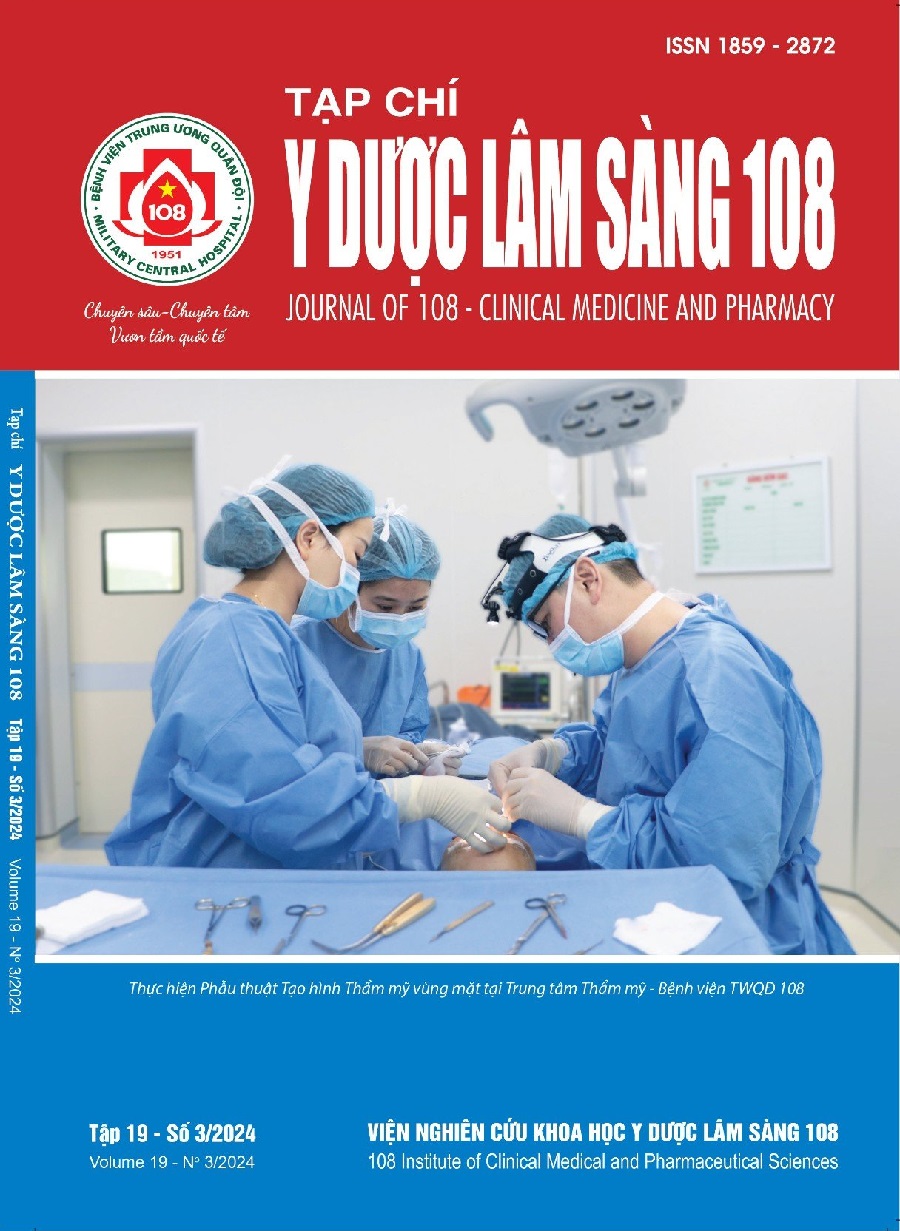Study the clinical and imaging characteristics of benign vertebral body collapse lesions due to osteoporosis
Main Article Content
Keywords
Abstract
Objective: To describe the clinical and paraclinical characteristics of benign vertebral body collapse due to osteoporois at Friendship Hospital. Subject and method: Prospective research was conducted, describing longitudinal follow-up analysis on 150 patients diagnosed with benign vertebral body collapse due to osteoporois at Friendship Hospital from January 2017 until April 2024. Result: 150 patients in the study group: Females accounted for the majority at 57.3%. The average age of the research group was 78.4 ± 8.9 years old, with the largest age group being over 80 years old at 46.7%. Four patients (2.7%) used corticosteroids, and five patients (3.4%) had chronic nephritis, including one patient with grade V chronic kidney failure (0.7%). Sixteen patients (10.7%) had collapse of the old vertebral body; however, only nine patients (6.0%) received percutaneous vertebroplasty. The majority of patients were hospitalized due to spinal pain, accounting for 97.3% of cases. The second most common symptom was paravertebral muscle contraction, with a rate of 31.3%. Among 196 collapsed vertebral bodies on X-ray, vertebral bodies T12, L1, L2 accounted for the highest rate, respectively, T12 collapsed at a rate of 24.5%; L1 collapse accounts for 31.6% and L2 vertebral body collapse accounts for 18.9%. There was no damage observed from the T4 body or above. The Cobb angle of the vertebra showed the most significant change, with the largest angle of 38.9°, the largest kyphosis angle of the vertebra being 32.4°, and the largest collapse angle being 22.1°. The height of the back wall was less variable than the front and middle walls. Among patients undergoing magnetic resonance imaging, 182 vertebral bodies showed bone marrow edema, with type 1 bone marrow edema accounting for the highest rate at 54.2%. The highest proportion of patients with bone marrow edema in one vertebral body was 73.5%. Conclusion: Benign vertebral body collapse due to osteoporois occurs mainly in the elderly and has a predominance in women. Common risk factors include patients using corticosteroids and smoking. Characteristics observed on X-ray and magnetic resonance imaging aid in diagnosing the injury as well as predicting treatment.
Article Details
References
2. Terence W, Felsenberg et al (2002) Incidence of Vertebral fracture in europe: Results from the european prospective osteoporosis study (EPOS)*. Journal of Bone and Mineral Research 17(4): 716-724. doi:10.1359/jbmr.2002.17.4.716.
3. Bigdon SF, Saldarriaga Y, Oswald KAC et al (2022) Epidemiologic analysis of 8000 acute vertebral fractures: Evolution of treatment and complications at 10-year follow-up. Journal of Orthopaedic Surgery and Research 17(1): 270.
4. Nguyen HT, Nguyen BT, Thai THN et al (2024) Prevalence, incidence of and risk factors for vertebral fracture in the community: The Vietnam Osteoporosis Study. Sci Rep 14(1): 32.
5. Al-Bashaireh AM, Haddad LG, Weaver M, Chengguo X, Kelly DL, Yoon S (2018) The Effect of tobacco smoking on bone mass: An overview of pathophysiologic mechanisms. J Osteoporos: 1206235.
6. Briot K, Roux C (2015) Glucocorticoid-induced osteoporosis. RMD Open 1(1): 000014.
7. Cramer GD, Darby SA, Cramer GD (2014) Clinical Anatomy of the Spine, Spinal Cord, and ANS. 3rd ed. Elsevier.
8. Đỗ Mạnh Hùng (2017) Nghiên cứu ứng dụng tạo hình đốt sống bằng bơm cement có bóng cho bệnh nhân xẹp đốt sống lưng do loãng xương. Luận Án Tiến sĩ. Trường Đại Học Y Hà Nội.
9. Li Q, Shi L, Wang Y et al (2021) A nomogram for predicting the residual back pain after percutaneous vertebroplasty for osteoporotic vertebral compression fractures. Pain Res Manag: 3624614.
10. Song D, Meng B, Chen G et al (2017) Secondary balloon kyphoplasty for new vertebral compression fracture after initial single-level balloon kyphoplasty for osteoporotic vertebral compression fracture. Eur Spine J 26(7): 1842-1851.
11. Ahn SE, Ryu KN, Park JS, Jin W, Park SY, Kim SB Early bone marrow edema pattern of the osteoporotic vertebral compression fracture : can be predictor of vertebral deformity types and prognosis? J Korean Neurosurg Soc 59(2): 137-142.
 ISSN: 1859 - 2872
ISSN: 1859 - 2872
